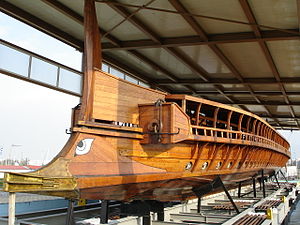Olympias (trireme)

Olympias
|
|
| History | |
|---|---|
|
|
|
| Name: | Olympias in its shed in the Naval Tradition Park, Palaio Faliro |
| Owner: | Hellenic Navy |
| Ordered: | 1985 |
| Laid down: | July 27, 1987 |
| Launched: | August 1987 |
| Commissioned: | August 26, 1987 |
| Homeport: | Palaio Faliro 37°56.057′N 23°41.11′E / 37.934283°N 23.68517°E |
| Status: | serves as exhibit in dry dock |
| General characteristics | |
| Type: | Trireme |
| Displacement: | 70 tonnes |
| Length: | 36.9 m (121 ft 1 in) |
| Beam: | 5.5 m (18 ft 1 in) |
| Draught: | 1.25 m (4 ft 1 in) |
| Propulsion: |
|
| Speed: |
|
| Troops: | 14 (10 Hoplites + 4 Archers) |
| Complement: | 200 including 5 officers (in antiquity) |
| Armament: | Bronze bow ram, ten spears, four archers |
Olympias is a reconstruction of an ancient Athenian trireme and an important example of experimental archaeology. It is also a commissioned ship in the Hellenic Navy of Greece, the only commissioned vessel of its kind in any of the world's navies.
Olympias was constructed from 1985 to 1987 by a shipbuilder in Piraeus. She was built to drawings by the naval architect John F. Coates which he developed through long discussions with the historian J. S. Morrison following the longest correspondence on any subject in The Times of London in the early 1980s. The work was also advised by the classics teacher Charles Willink and drew on evidence gained from Greek literature, history of art and archaeology above and below water. Finance came from the Hellenic Navy and donors such as Frank Welsh (a banker, writer and trireme enthusiast). Morrison, Coates and Willink founded the Trireme Trust together with Welsh. The Trireme Trust is now chaired by professor Boris Rankov.
The bronze bow ram weighs 200 kg. It is a copy of an original ram now in the Piraeus archaeological museum. The ship was built from Oregon pine and Virginia oak. The keel is of iroko.
The important hypozomata (bracing ropes) had to be replaced by a steel rope because no natural fibre or synthetic fibre ropes with about the same elastic modulus as hemp could be obtained. The steel cables' tension varied as the hull bent on the waves, rather than exerting constant tension like a natural fibre rope. This caused the alarming possibility of the rope breaking and endangering the crew, so protective measures had to be taken.
...
Wikipedia
